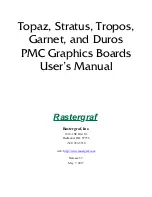
2.3 Digitizer firmware (DGT option)
U5303A User's Manual
17
2.3 Digitizer firmware (DGT option)
The digitizer firmware (normal mode) allows standard data acquisition, including: ADC card
initialization, setting of the acquisition and clocking modes, management of channel triggering for best
synchronization, storing data in the internal memory and/or transferring them to the host computer.
Single and multi-record acquisition modes
To maximize sampling rates and utilize memory as efficiently as possible the ADC cards include both
single and multi-record modes. For both of these modes the data of all of the active channels is
acquired synchronously; all of the ADC's are acquiring data at the same time, to within a small fraction
of the maximum sampling rate.
The
single record acquisition mode
is the normal operation of most ADC card products. In this
mode an acquisition consists of a waveform recorded with a single trigger. The user selects the
sampling rate and record size, and sets the number of records to 1 (default value). For details about the
trigger sources, see
.
Figure 2.1 -
Acquisition sequence using a single record.
The ADC cards also feature a
multi-record acquisition mode
. This mode allows the capture and
storage of consecutive single waveforms. Multi-record acquisition mode is useful as it can optimize
the ADC card's sampling rate and memory requirements for applications where only portions of the
signal being analyzed are important. The mode is extremely useful in almost all impulse-response type
applications (RADAR, SONAR, LIDAR, Time-of-Flight, Ultrasonics, Medical and Biomedical
Research, etc.).
In multi-record acquisition mode the acquisition memory is divided into a pre-selected number of
records. Waveforms are stored in successive memory records as they arrive. Each waveform requires
its own individual trigger.
Figure 2.2 -
Acquisition sequence using a multi-records. It is possible to miss a trigger at high trigger rate, as
illustrated with trigger 3.
















































